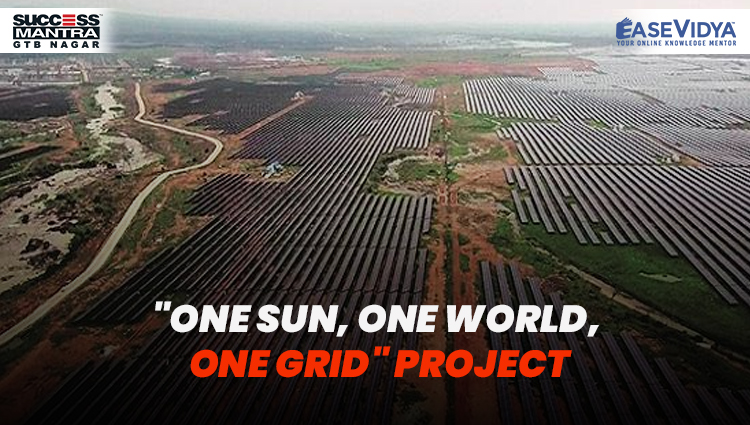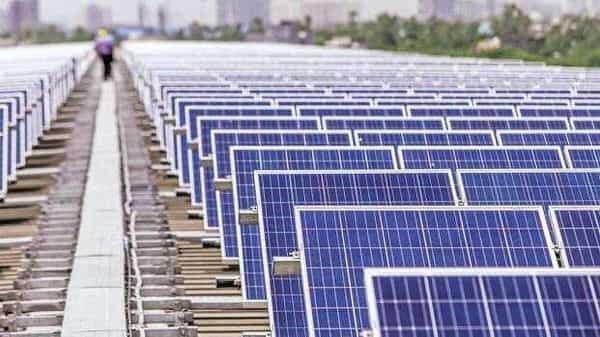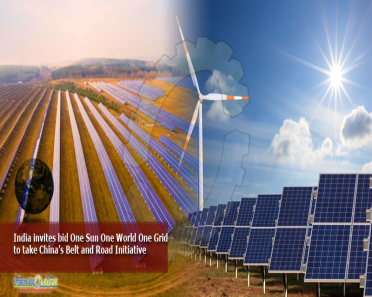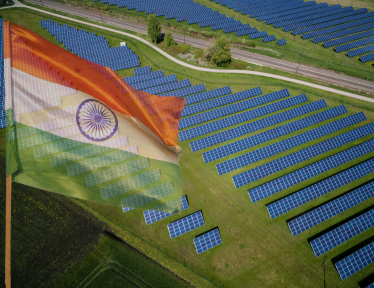
ONE SUN ONE WORLD ONE GRID PROJECT
"ONE SUN, ONE WORLD, ONE GRID" PROJECT
India and the UK are likely to announce a joint declaration on “one sun, one world, one grid” — or OSOWOG at the upcoming Conference of Parties (COP26). The UN Climate Change Conference, or COP26, is scheduled to be held between 31st October and 12th November in Scotland. The concept of OSOWOG is what the British have called a green grid. The idea behind the concept is a trans-national electricity grid supplying solar power across the globe.

Current Affairs Notes By Success Mantra Coaching Institute GTB Nagar Delhi CLICK HERE
OSOWOG OR THE GREEN GRID
The vision behind the OSOWOG is ‘The Sun Never Sets’ and is a constant at some geographical location, globally, at any given point of time. This is by far one of the most ambitious schemes undertaken by any country (India) and is of global significance in terms of sharing economic benefits. It has been taken up under the technical assistance program of the World Bank. The OSOWOG plan may also leverage the International Solar Alliance (ISA), co-founded by India that has 80 countries as members. With India in the middle, the solar spectrum can easily be divided into two broad zones, which are: Far East including countries like Myanmar, Vietnam, Thailand, Lao, Cambodia etc. far West covering the Middle East and the Africa Region.
Three Phases of the Plan:
- First Phase: It will entail interconnectivity within the Asian continent.
- Second Phase: It will add Africa.
- Third Phase: It is about global interconnection.
SIGNIFICANCE OF THE PROJECT
Help all the participating entities in attracting investments in renewable energy sources as well as utilizing skills, technology and finances. Lead to reduced project costs, higher efficiencies and increased asset utilization for all the participating entities. Resulting economic benefits would positively impact poverty alleviation and support in mitigating water, sanitation, food and other socio-economic challenges. Allow national renewable energy management centres in India to grow as regional and global management centres. This move, during the time of the Covid-19 pandemic, gives India the opportunity to be seen as taking a lead in evolving global strategies.

ISSUES WITH THE PROJECT
- Geopolitics: The project is seen as an Indian endeavour for world leadership but under Covid-19 uncertainties, the geopolitical implications of projects like OSOWOG are hard to decipher. The mechanism of cost-sharing will be challenging, given the varied priorities of participating countries depending on their socio-economic orders.
- Globalisation v. De-Globalisation: The OSOWOG will turn out to be an expensive, complex and very slow progress project. The strategic benefits, if any, of having a single grid will be obliterated in the wake of any geopolitical problem. In India, the major issue of renewable energy developers is to deal with different state governments and hence, different laws and regulations. Further, the project also contradicts the Prime Minister’s Aatmanirbhar Bharat (self-dependent India) vision, as it extends the reliance for a major strategic entity, energy supply, to other countries through this grid.
- Centralised v. Distributed Generation: There is a difference in voltage, frequency and specifications of the grid in most regions. Maintaining grid stability with just renewable generation would be technically difficult.
WHAT IS INTERNATIONAL SOLAR ALLIANCE
The ISA, is an Indian initiative that was launched by the Prime Minister of India and the President of France on 30th November 2015 in Paris, France on the side-lines of the Conference of the Parties (COP-21), with 121 solar resource rich countries lying fully or partially between the tropic of Cancer and tropic of Capricorn as prospective members. The overarching objective of the ISA is to collectively address key common challenges to the scaling up of solar energy in ISA member countries. The Government of India has allotted 5 acres of land to the ISA in National Institute of Solar Energy (NISE) campus, Gurugram and has released a sum of Rs. 160 crore for creating a corpus fund, building infrastructure and meeting day to day recurring expenditure of the ISA up to the year 2021-22.

ABOUT UNFCCC
The United Nations Framework Convention on Climate Change (UNFCCC), signed in 1992 at the United Nations Conference on Environment and Development also known as the Earth Summit, the Rio Summit or the Rio Conference. India is among the select few countries to have hosted the COP of all three Rio conventions on climate change (UNFCCC), biodiversity (Convention on Biological Diversity) and land (United Nations Convention to Combat Desertification). The UNFCCC entered into force on 21st March 1994, and has been ratified by 197 countries. It is the parent treaty of the 2015 Paris Agreement. It is also the parent treaty of the 1997 Kyoto Protocol. The UNFCCC secretariat (UN Climate Change) is the United Nations entity tasked with supporting the global response to the threat of climate change. It is located in Bonn, Germany.
About COP-26: COP-26 is extended as “The 2021 United Nations Climate Change Conference”. It is the 26th United Nations Climate Change conference, which is scheduled to be held in the city of Glasgow, Scotland. It will be held from 31 October to 12 November 2021. The United Kingdom holds the presidency of the conference. Conference will also incorporate the 26th Conference of Parties to the United Nations Framework Convention on Climate Change (UNFCCC), third meeting of parties to the Paris Agreement (CMA3) and 16th meeting of the parties to the Kyoto Protocol (CMP16). During this conference, Parties are expected to commit to enhanced ambition for the first time since COP21.
CONCLUSION
The move is the key to future renewable-based energy systems globally because regional and international interconnected green grids can enable sharing and balancing of renewable energy across international borders. It allows grabbing opportunities to learn quickly from global developments and share renewable energy resources to reduce the global carbon footprint and insulate the societies from pandemics. Institution building is key to fulfilling the ambitions of a multi-country grid project. In this context, ISA (International Solar Alliance) can act as an independent supranational institution to take decisions about how the grid should be run and conflicts settled.
PRAVAHINI Current Affairs Notes By Success Mantra Coaching Institute GTB Nagar Delhi CLICK HERE
TEST YOURSELF
Q.1 Which of the following two countries are likely to announce a joint declaration on “one sun, one world, one grid” — or OSOWOG at the upcoming Conference of Parties (COP26)?
- India & United States of America
- France & India
- India & United Kingdom: ANSWER
- United Kingdom & France
Q.2 Consider the given below statements & state which of the following is/are correct in the reference to the above mentioned passage?
- The vision behind the OSOWOG is ‘The Sun Never Sets’ and is a constant at some geographical location, globally, at any given point of time: ANSWER
- It is one of the most ambitious schemes undertaken by any country (United Kingdom) and is of global significance in terms of sharing economic benefits.
- It has been taken up under the technical assistance program of the International Monetary Fund (IMF).
- None of the above
Q.3 The UN Climate Change Conference, or conference of parties COP26, is scheduled to be held in _________?
- Paris, France
- Washington DC, USA
- Berne, Switzerland
- Glasgow, Scotland: ANSWER
Q.4 The ISA which is an Indian initiative that was launched by which of the following two countries on the side-lines of the Conference of the Parties (COP-21)?
- India & United Kingdom
- France & India: ANSWER
- France & United Kingdom
- None of the above
Q.5 The UNFCCC secretariat (UN Climate Change) which is the United Nations entity tasked with supporting the global response to the threat of climate change is headquartered at ________?
- Oslo, Norway
- Bonn, Germany: ANSWER
- Stockholm, Sweden
- None of the above












cflyehdjs
ONE SUN ONE WORLD ONE GRID PROJECT | Read Daily Article Editorials Only On Success Mantra Blog | Daily Article | Monthly Article | Weekly Article | Yearly Article | Most Requesting Articles | Legal Awareness Articles | Current Affairs | Passage Based Current Affairs | One Linear Current Affairs | Current Affairs For CLAT | Current Affairs For AILET | Current Affairs For Slat | Legal Aptitude Current Affairs | Law Current Affairs | Current Event | Current Affairs Pdf | Current Affairs Pdf In English | Current Affairs Pdf Free Download | Current Affairs MCQ | Current Affairs MCQS | Current Affairs Work Sheet | Current Affairs UPSC | Current Affairs BBA | Current Affairs BCA | Current Affairs BJMC | Current Affairs NCHMJEE | Daily Editorial | Monthly Editorial | Weekly Editorial | Yearly Editorial | Most Asking Editorials | Legal Awareness Editorials | Current Editorial | Passage Based Current Editorial | One Linear Current Editorial | Current Editorial For CLAT | Current Editorial For AILET | Current Editorial For Slat | Legal Aptitude Current Editorial | Law Current Editorial | Current Event | Current Editorial Pdf | Current Editorial Pdf In ENGLISH | Current Editorial Pdf Free Download | Current Editorial MCQ | Current Editorial MCQS | Current Editorial Work Sheet | Current Editorial UPSC | Current Editorial BBA | Current Editorial BCA | Current Editorial BJMC | Current Editorial NCHMJEE | Latest News In India | Latest News In Hindi | Latest News Delhi | Latest News Today India | Latest News Live | 3 Latest News | Latest News Today Delhi | Latest News Aajtak | News Articles India | News Articles For Students | News Articles 2020 | News Articles In English | News Articles In Hindi | News Article Example | Short News Articles | News Article Meaning | Success Mantra Delhi | CLAT Coaching In Delhi | Best CLAT Du LLB Institute In Delhi | Read Daily Article Editorials Only On Success Mantra Blog cflyehdjs http://www.g0y75st0za3a30918hhflzj16d24e51vs.org/ [url=http://www.g0y75st0za3a30918hhflzj16d24e51vs.org/]ucflyehdjs[/url] <a href="http://www.g0y75st0za3a30918hhflzj16d24e51vs.org/">acflyehdjs</a>
jcpieiqhbx
ONE SUN ONE WORLD ONE GRID PROJECT | Read Daily Article Editorials Only On Success Mantra Blog | Daily Article | Monthly Article | Weekly Article | Yearly Article | Most Requesting Articles | Legal Awareness Articles | Current Affairs | Passage Based Current Affairs | One Linear Current Affairs | Current Affairs For CLAT | Current Affairs For AILET | Current Affairs For Slat | Legal Aptitude Current Affairs | Law Current Affairs | Current Event | Current Affairs Pdf | Current Affairs Pdf In English | Current Affairs Pdf Free Download | Current Affairs MCQ | Current Affairs MCQS | Current Affairs Work Sheet | Current Affairs UPSC | Current Affairs BBA | Current Affairs BCA | Current Affairs BJMC | Current Affairs NCHMJEE | Daily Editorial | Monthly Editorial | Weekly Editorial | Yearly Editorial | Most Asking Editorials | Legal Awareness Editorials | Current Editorial | Passage Based Current Editorial | One Linear Current Editorial | Current Editorial For CLAT | Current Editorial For AILET | Current Editorial For Slat | Legal Aptitude Current Editorial | Law Current Editorial | Current Event | Current Editorial Pdf | Current Editorial Pdf In ENGLISH | Current Editorial Pdf Free Download | Current Editorial MCQ | Current Editorial MCQS | Current Editorial Work Sheet | Current Editorial UPSC | Current Editorial BBA | Current Editorial BCA | Current Editorial BJMC | Current Editorial NCHMJEE | Latest News In India | Latest News In Hindi | Latest News Delhi | Latest News Today India | Latest News Live | 3 Latest News | Latest News Today Delhi | Latest News Aajtak | News Articles India | News Articles For Students | News Articles 2020 | News Articles In English | News Articles In Hindi | News Article Example | Short News Articles | News Article Meaning | Success Mantra Delhi | CLAT Coaching In Delhi | Best CLAT Du LLB Institute In Delhi | Read Daily Article Editorials Only On Success Mantra Blog <a href="http://www.g9dcp31ay265c2mq78f0o3e5xt606h8xs.org/">ajcpieiqhbx</a> [url=http://www.g9dcp31ay265c2mq78f0o3e5xt606h8xs.org/]ujcpieiqhbx[/url] jcpieiqhbx http://www.g9dcp31ay265c2mq78f0o3e5xt606h8xs.org/
kkbzhbwxse
ONE SUN ONE WORLD ONE GRID PROJECT | Read Daily Article Editorials Only On Success Mantra Blog | Daily Article | Monthly Article | Weekly Article | Yearly Article | Most Requesting Articles | Legal Awareness Articles | Current Affairs | Passage Based Current Affairs | One Linear Current Affairs | Current Affairs For CLAT | Current Affairs For AILET | Current Affairs For Slat | Legal Aptitude Current Affairs | Law Current Affairs | Current Event | Current Affairs Pdf | Current Affairs Pdf In English | Current Affairs Pdf Free Download | Current Affairs MCQ | Current Affairs MCQS | Current Affairs Work Sheet | Current Affairs UPSC | Current Affairs BBA | Current Affairs BCA | Current Affairs BJMC | Current Affairs NCHMJEE | Daily Editorial | Monthly Editorial | Weekly Editorial | Yearly Editorial | Most Asking Editorials | Legal Awareness Editorials | Current Editorial | Passage Based Current Editorial | One Linear Current Editorial | Current Editorial For CLAT | Current Editorial For AILET | Current Editorial For Slat | Legal Aptitude Current Editorial | Law Current Editorial | Current Event | Current Editorial Pdf | Current Editorial Pdf In ENGLISH | Current Editorial Pdf Free Download | Current Editorial MCQ | Current Editorial MCQS | Current Editorial Work Sheet | Current Editorial UPSC | Current Editorial BBA | Current Editorial BCA | Current Editorial BJMC | Current Editorial NCHMJEE | Latest News In India | Latest News In Hindi | Latest News Delhi | Latest News Today India | Latest News Live | 3 Latest News | Latest News Today Delhi | Latest News Aajtak | News Articles India | News Articles For Students | News Articles 2020 | News Articles In English | News Articles In Hindi | News Article Example | Short News Articles | News Article Meaning | Success Mantra Delhi | CLAT Coaching In Delhi | Best CLAT Du LLB Institute In Delhi | Read Daily Article Editorials Only On Success Mantra Blog <a href="http://www.gy6od9l9k7l86231f6l886kv4hr60lmjs.org/">akkbzhbwxse</a> kkbzhbwxse http://www.gy6od9l9k7l86231f6l886kv4hr60lmjs.org/ [url=http://www.gy6od9l9k7l86231f6l886kv4hr60lmjs.org/]ukkbzhbwxse[/url]
hmfbeqqvij
ONE SUN ONE WORLD ONE GRID PROJECT | Read Daily Article Editorials Only On Success Mantra Blog | Daily Article | Monthly Article | Weekly Article | Yearly Article | Most Requesting Articles | Legal Awareness Articles | Current Affairs | Passage Based Current Affairs | One Linear Current Affairs | Current Affairs For CLAT | Current Affairs For AILET | Current Affairs For Slat | Legal Aptitude Current Affairs | Law Current Affairs | Current Event | Current Affairs Pdf | Current Affairs Pdf In English | Current Affairs Pdf Free Download | Current Affairs MCQ | Current Affairs MCQS | Current Affairs Work Sheet | Current Affairs UPSC | Current Affairs BBA | Current Affairs BCA | Current Affairs BJMC | Current Affairs NCHMJEE | Daily Editorial | Monthly Editorial | Weekly Editorial | Yearly Editorial | Most Asking Editorials | Legal Awareness Editorials | Current Editorial | Passage Based Current Editorial | One Linear Current Editorial | Current Editorial For CLAT | Current Editorial For AILET | Current Editorial For Slat | Legal Aptitude Current Editorial | Law Current Editorial | Current Event | Current Editorial Pdf | Current Editorial Pdf In ENGLISH | Current Editorial Pdf Free Download | Current Editorial MCQ | Current Editorial MCQS | Current Editorial Work Sheet | Current Editorial UPSC | Current Editorial BBA | Current Editorial BCA | Current Editorial BJMC | Current Editorial NCHMJEE | Latest News In India | Latest News In Hindi | Latest News Delhi | Latest News Today India | Latest News Live | 3 Latest News | Latest News Today Delhi | Latest News Aajtak | News Articles India | News Articles For Students | News Articles 2020 | News Articles In English | News Articles In Hindi | News Article Example | Short News Articles | News Article Meaning | Success Mantra Delhi | CLAT Coaching In Delhi | Best CLAT Du LLB Institute In Delhi | Read Daily Article Editorials Only On Success Mantra Blog [url=http://www.g42zi6me259uyw120t7w57bx906htu0hs.org/]uhmfbeqqvij[/url] hmfbeqqvij http://www.g42zi6me259uyw120t7w57bx906htu0hs.org/ <a href="http://www.g42zi6me259uyw120t7w57bx906htu0hs.org/">ahmfbeqqvij</a>
yboimvtsiv
ONE SUN ONE WORLD ONE GRID PROJECT | Read Daily Article Editorials Only On Success Mantra Blog | Daily Article | Monthly Article | Weekly Article | Yearly Article | Most Requesting Articles | Legal Awareness Articles | Current Affairs | Passage Based Current Affairs | One Linear Current Affairs | Current Affairs For CLAT | Current Affairs For AILET | Current Affairs For Slat | Legal Aptitude Current Affairs | Law Current Affairs | Current Event | Current Affairs Pdf | Current Affairs Pdf In English | Current Affairs Pdf Free Download | Current Affairs MCQ | Current Affairs MCQS | Current Affairs Work Sheet | Current Affairs UPSC | Current Affairs BBA | Current Affairs BCA | Current Affairs BJMC | Current Affairs NCHMJEE | Daily Editorial | Monthly Editorial | Weekly Editorial | Yearly Editorial | Most Asking Editorials | Legal Awareness Editorials | Current Editorial | Passage Based Current Editorial | One Linear Current Editorial | Current Editorial For CLAT | Current Editorial For AILET | Current Editorial For Slat | Legal Aptitude Current Editorial | Law Current Editorial | Current Event | Current Editorial Pdf | Current Editorial Pdf In ENGLISH | Current Editorial Pdf Free Download | Current Editorial MCQ | Current Editorial MCQS | Current Editorial Work Sheet | Current Editorial UPSC | Current Editorial BBA | Current Editorial BCA | Current Editorial BJMC | Current Editorial NCHMJEE | Latest News In India | Latest News In Hindi | Latest News Delhi | Latest News Today India | Latest News Live | 3 Latest News | Latest News Today Delhi | Latest News Aajtak | News Articles India | News Articles For Students | News Articles 2020 | News Articles In English | News Articles In Hindi | News Article Example | Short News Articles | News Article Meaning | Success Mantra Delhi | CLAT Coaching In Delhi | Best CLAT Du LLB Institute In Delhi | Read Daily Article Editorials Only On Success Mantra Blog [url=http://www.gh0350y5110p6raflz7z7kkt460t32tss.org/]uyboimvtsiv[/url] <a href="http://www.gh0350y5110p6raflz7z7kkt460t32tss.org/">ayboimvtsiv</a> yboimvtsiv http://www.gh0350y5110p6raflz7z7kkt460t32tss.org/